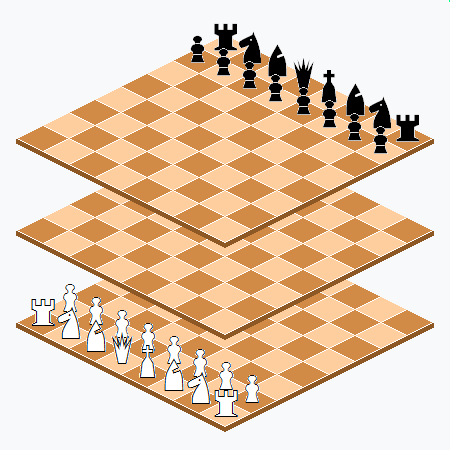Millennium 3D Chess on:
[Wikipedia]
[Google]
[Amazon]
 Millennium 3D chess is a three-dimensional
Millennium 3D chess is a three-dimensional
1. ♘2g3 ♝2b7 2. ♗3e3 ♞3c6 3. ♘2b3 ♝2g7 4. ♘2a5 ♛1b6 5. ♘3c5 ♛×1b2 6. ♘×3b7 ♛3b4 7. ♘3c5 ♛3e1+ 8. ♕2e1 ♛3c3+ 9. ♔2f1 ♛×1a1 10. ♕2c1 ♝2a6+ 11. 2e2 ♛×1a2 12. ♘2c7 ♜2h7 13. ♘1e7+ ♚2e8 14. ♘1c6 ♜1c8 15. ♘×3c7 ♜×1c2 16. ♕2c7 ♛2b1+ 17. ♔1g1 ♞3e5 18. ♕1d7+ ♚2f8 19. ♗2f4 ♛2d1 20. ♗×3e5 ♛3e1+ 21. ♔2g1 ♛×3e5 22. ♕2e7+ ♚1g7 23. ♕×3d7 ♝2d4+ 24. 2e3 ♜2c1+ 25. ♔1g1 ♛3g3+ 26. 2g2 ♜2f1+ 27. ♘×2f1 ♝3e3+ 28. 2f2 ♛×2f2
 Millennium 3D chess is a three-dimensional
Millennium 3D chess is a three-dimensional chess variant
A chess variant is a game related to, derived from, or inspired by chess. Such variants can differ from chess in many different ways.
"International" or "Western" chess itself is one of a family of games which have related origins and could be co ...
created by William L. d'Agostino in 2001. It employs three vertically stacked 8×8 boards
Board or Boards may refer to:
Flat surface
* Lumber, or other rigid material, milled or sawn flat
** Plank (wood)
** Cutting board
** Sounding board, of a musical instrument
* Cardboard (paper product)
* Paperboard
* Fiberboard
** Hardboard, ...
, with each player controlling a standard set of chess piece
A chess piece, or chessman, is a game piece that is placed on a chessboard to play the game of chess. It can be either White and Black in chess, white or black, and it can be one of six types: King (chess), king, Queen (chess), queen, Rook (chess ...
s. The inventor describes his objective as "extending the traditional chess game into a multilevel environment without distorting the basic game."
Rules
Millennium 3D сhess extends the traditional (two-dimensional) game of chess into a multi-level environment. For notation purposes, the three board levels are denoted 1, 2 (the middle board), and 3. Moves are recorded in the same manner as chess, using algebraic notation, with the only difference that each square is prefaced by its level number. The white and black armies begin, in standard formation, on boards 1 and 3 respectively. All pieces can always move as normal while staying on the same board. Additionally, every piece is able to move between boards. Each piece's additional permitted movement in the third dimension is extended from its conventional 2D movement as follows: *The king can move one square up or down, either directly or combined with its regular movement. *The knight can move up or down one board and two squares orthogonally, or up or down two boards and one square orthogonally. As in standard chess, the knight is the only piece able to move past intervening pieces. *The bishop can move up or down one or two boards, as long as it also moves the same number of squares in a diagonal direction. *The rook can move vertically up and down while not moving in the other two dimensions. Additionally, a rook can move an equal number of squares vertically as it does in one of the lateral dimensions. *The queen moves as the bishop and rook combined. *The pawn can move one square up or down while staying in the same position laterally, or it can advance one square and additionally move one board up or down. Optionally, the pawn's first move can be two squares vertically, or two squares forward and two squares vertically. The pawn can capture diagonally forwards onto a board immediately above or below it. After a pawn's two-step first move, unless that move was two squares vertically only, the pawn may be captured '' en passant'' on the square it passed through. Promotion occurs at the opponent's back rank and starting board; i.e. White promotes at rank 8 of board 3, and Black promotes at rank 1 of board 1.Example game
George Davis vs. William d'Agostino, corr. 2006:1. ♘2g3 ♝2b7 2. ♗3e3 ♞3c6 3. ♘2b3 ♝2g7 4. ♘2a5 ♛1b6 5. ♘3c5 ♛×1b2 6. ♘×3b7 ♛3b4 7. ♘3c5 ♛3e1+ 8. ♕2e1 ♛3c3+ 9. ♔2f1 ♛×1a1 10. ♕2c1 ♝2a6+ 11. 2e2 ♛×1a2 12. ♘2c7 ♜2h7 13. ♘1e7+ ♚2e8 14. ♘1c6 ♜1c8 15. ♘×3c7 ♜×1c2 16. ♕2c7 ♛2b1+ 17. ♔1g1 ♞3e5 18. ♕1d7+ ♚2f8 19. ♗2f4 ♛2d1 20. ♗×3e5 ♛3e1+ 21. ♔2g1 ♛×3e5 22. ♕2e7+ ♚1g7 23. ♕×3d7 ♝2d4+ 24. 2e3 ♜2c1+ 25. ♔1g1 ♛3g3+ 26. 2g2 ♜2f1+ 27. ♘×2f1 ♝3e3+ 28. 2f2 ♛×2f2
References
Bibliography *External links
* {{Chess variants, state=collapsed Chess variants 2001 in chess Board games introduced in 2001